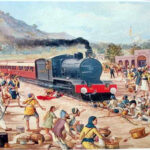The empire of the Sikhs was most exceptional in that it allowed men from religions other than their own to rise to commanding positions of authority. Besides the Singh (Sikh), the Khan (Muslim) and the Misr (Hindu Brahmin) feature as prominent administrators. The Christians formed a part of the militia of the Sikhs. In 1831, Ranjit Singh deputed his mission to Simla to confer with the British Governor General, Lord William Bentinck. Sardar Hari Singh Nalwa, Fakir Aziz-ud-din and Diwan Moti Ram ― a Sikh, a Muslim and a Hindu representative ― were nominated at its head.
Wives of Ranjit Singh
Rani Mehtab Kaur of Town of Batala (Gurdaspur District) , Rani Raj kaur (d.1838) of Baherwal (Kasur District), Rani Rattan kaur and Rani Daya Kaur of Gujrat, Rani Chand kaur (d.1840) of Village Chainpur (Amritsar District), Rani Gulab Kaur (d.1838) of Village Jagdeo (Amritsar District), Rani Lachhmi Kaur of Vilage Jogki Khan (Gujranwala District), Rani Jind kaur (1817-1863) of Village Chachar (Gujranwala District), Rani Raj Banso Devi(d.1835)of Kangra Hill State.

The spire and ceilings of Kashi Vishwanath Temple (rebuilt in 1780) in Varanasi were plated with 820 Kilograms of gold gifted by Ranjit Singh in 1839.
Externally, everyone in the Sikh empire looked alike; they supported a beard and covered their head, predominantly with a turban. This left visitors to the Punjab quite confused. Most foreigners arrived there after a passage through Hindustan, where religious and caste distinctions were very carefully observed. It was difficult for them to believe that though everyone in the Sarkar Khalsaji looked similar, they were not all Sikhs. The Sikhs were generally not known to force either those in their employ or the inhabitants of the country they ruled to convert to Sikhism. In fact, men of piety from all religions were equally respected by the Sikhs and their ruler. Hindu sadhus, yogis, saints and bairagis; Muslim faqirs and pirs; and Christian priests were all the recipients of Sikh largess. There was only one exception – the Sikhs viewed the Muslim clergy with suspicion. Mullahs were not looked upon kindly, as they were known to fan fanaticism.

In their conquests, the Sikhs never perpetrated atrocities as by invaders into the sub-continent. It was true that the Sikhs held a grudge against the Afghans for the atrocities they had perpetrated, over decades, against them. Before them, the Mughals had hunted down the Sikhs like animals in the field. Every Sikh carried a price on his head. The Afghans had caused havoc and mayhem in the Punjab during the lifetime of both Ranjit Singh’s father and grandfather. Despite that, during the rule of the Sikhs there were no reports of torture of the kind routinely inflicted upon the Sikhs by some of the Muslim rulers of Hindustan and subsequently by the Afghan invaders. The Sikhs were reportedly a most tolerant nation.
The Sikhs were never accused of the routine inhumane behavior attributed to the Muslims. In fact, they made every attempt not to offend the prejudices of Muslims noted Baron von Hügel, the famous German traveler, yet the Sikhs were referred to as being harsh. In this regard, Masson’s explanation is perhaps the most pertinent:
“Though compared to the Afghans, the Sikhs were mild and exerted a protecting influence, yet no advantages could compensate to their Mohaomedan subjects, the idea of subjection to infidels, and the prohibition to slay kine, and to repeat the azan, or summons to prayer”.
Hinduism emphasizes the sanctity of cows, which has carried over into Sikhism. The ban on cow slaughter was universally imposed in the Sarkar Khalsaji.
The Sikhs never razed places of worship to the ground belonging to the enemy. The Sikhs were utilitarian in their approach. Marble plaques removed from Jahangir’s tomb at Shahdera were used to embellish the Baradari inside the Fort of Lahore, while the mosques were left intact. Forts were destroyed however, these too were often rebuilt ― the best example being the Bala Hissar in Peshawar, which were destroyed by the Sikhs in 1823 and rebuilt by them in 1834.





